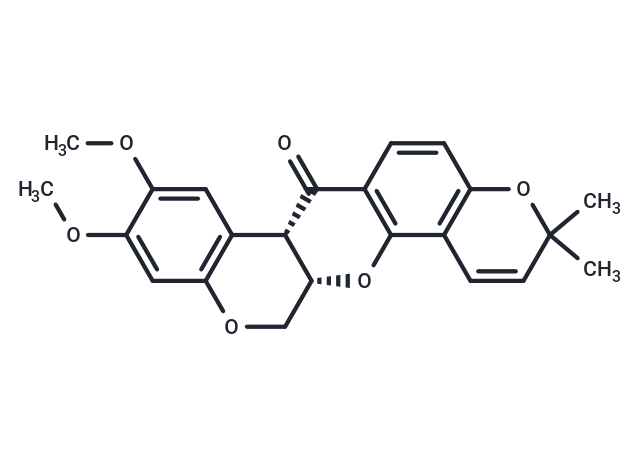Shopping Cart
- Remove All
 Your shopping cart is currently empty
Your shopping cart is currently empty

Deguelin ((-)-Deguelin) is a PI3K/AKT Inhibitor, which is a natural product isolated from plants in the Mundulea sericea family.

| Pack Size | Price | Availability | Quantity |
|---|---|---|---|
| 5 mg | $44 | In Stock | |
| 10 mg | $75 | In Stock | |
| 25 mg | $135 | In Stock | |
| 50 mg | $261 | In Stock | |
| 100 mg | $438 | In Stock | |
| 1 mL x 10 mM (in DMSO) | $50 | In Stock |
| Description | Deguelin ((-)-Deguelin) is a PI3K/AKT Inhibitor, which is a natural product isolated from plants in the Mundulea sericea family. |
| In vitro | In leukaemia cell lines, Deguelin downregulates Akt phosphorylation through activating PI3K/Akt axis. Deguelin increases the sensitivity of human leukaemia cells to chemotherapeutic drugs. In U937 cells deguelin does not affect the expression or the phosphorylation levels of either p44/42 or p38 MAP kinases. Deguelin, when employed for 24 h at 10 nmol/l, causes an S phase arrest of U937 cells, with interference of progression to G2/M phase. While employed alone up to a concentration of 10 nmol/l for 24 h, Deguelin does not significantly increase the apoptotic rate of U937 cells.Deguelin (10 or 100 nmol/l) is potent in inhibiting Akt phosphorylation,while deguelin does not affect total Akt expression. Deguelin dephosphorylates Akt and increases cytarabine sensitivity of AML blasts but not of CB CD34+. |
| In vivo | In pre-clinical trials, deguelin markedly decreased the tumor incidence. It exhibited significant anti-tumorigenesis and anti-proliferative activity in various types of cancer both in vitro and in vivo. Topically-administered deguelin significantly suppressed the multiplicity of skin tumors with UVB-induction, indicating its effect as a potential cancer chemopreventive agent. Treatment with deguelin, a potential mitochondria complex I inhibitor, reduced tyrosine hydroxylase-positive neurons, leading to Parkinson's disease.Deguelin promoted a PD-like syndrome, mainly by Src/STAT signaling, since α-synuclein (a key protein function in the pathogenesis of PD) was phosphorylated by deguelin-activated Src.Deguelin inhibits in vivo angiogenesis of chick chorioallantoic membrane (CAM) without cytotoxic effect and significantly reduces laser-induced CNV in a mouse model of AMD without significant retinal toxicity. In A/J mice, deguelin clearly reduced the tumor multiplicity and volume, as well as the overall tumor burden with exposure to the tobacco-specific carcinogen benzo(a)pyrene (Bap) and other carcinogens, with no detectable toxicity. |
| Kinase Assay | Caspase 3 activity is determined using Caspase-Glo-3 assays. This assay provides luminogenic substrate in a buffer system optimized for each specific caspase activity. The caspase cleavage of the substrate is followed by generation of a luminescent signal. The signal generated is proportional to the amount of caspase activity present in the sample. Protein (10 μg) from the cell samples is diluted in water to a final volume of 50 μL and added to a white 96-well microtitre plate, followed by 50 μL of Caspase-Glo-3 reagent. The plate is sealed and gently mixed at 300-500 rpm for 30 s and incubated at room temperature for 30 min. Luminescence is measured in a microplate reader (TECAN Infinite 200). |
| Cell Research | U937 Cells are incubated with the indicated concentrations (1 nM, 10 nM, 100 nM) of deguelin for 24 h.Flow cytometric analysis of cell cycle in response to deguelin. Flow cytometric analysis of cell cycle in response to deguelin. |
| Animal Research | A/J mice were treated by oral gavage of 5.0 or 10.0 mg/kg deguelin dissolved in corn oil. |
| Alias | (-)-Deguelin |
| Molecular Weight | 394.42 |
| Formula | C23H22O6 |
| Cas No. | 522-17-8 |
| Smiles | COc1cc2OC[C@H]3Oc4c(ccc5OC(C)(C)C=Cc45)C(=O)[C@H]3c2cc1OC |
| Relative Density. | 1.255g/cm3 |
| Storage | Powder: -20°C for 3 years | In solvent: -80°C for 1 year | Shipping with blue ice. | ||||||||||||||||||||||||||||||||||||||||
| Solubility Information | Ethanol: 19.7 mg/mL (49.95 mM), Sonication is recommended. DMSO: 50 mg/mL (126.77 mM), Sonication is recommended. | ||||||||||||||||||||||||||||||||||||||||
Solution Preparation Table | |||||||||||||||||||||||||||||||||||||||||
Ethanol/DMSO
DMSO
| |||||||||||||||||||||||||||||||||||||||||

Copyright © 2015-2025 TargetMol Chemicals Inc. All Rights Reserved.